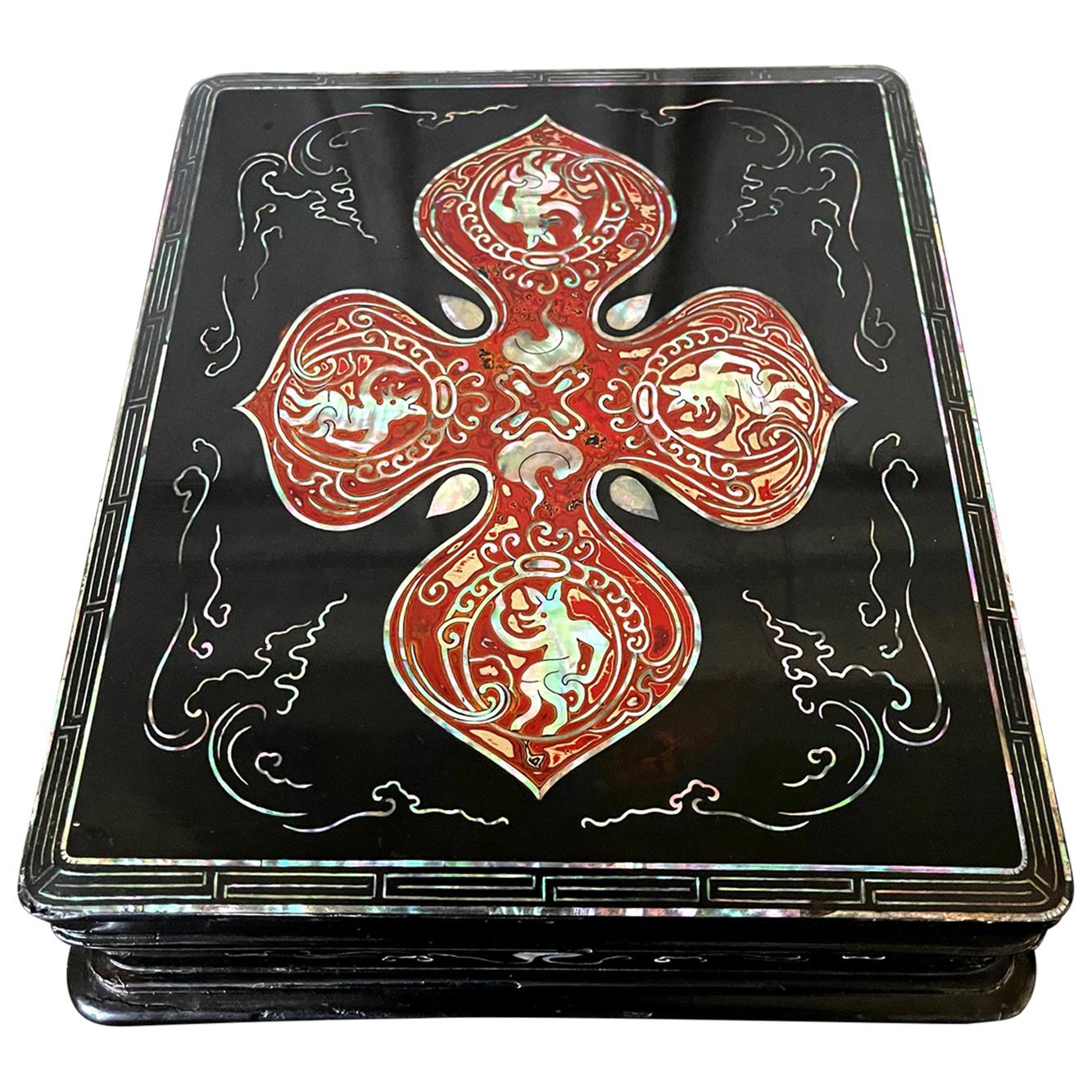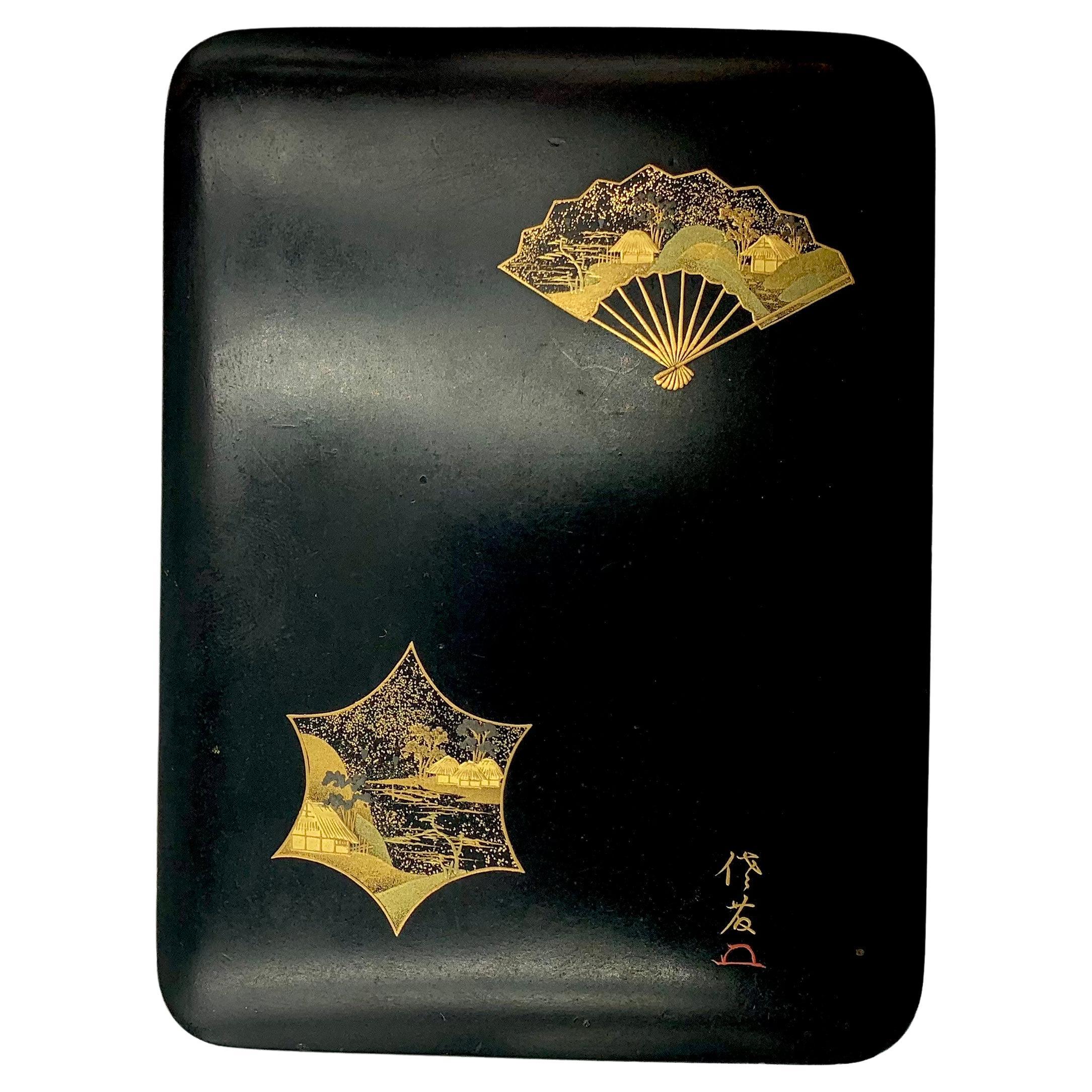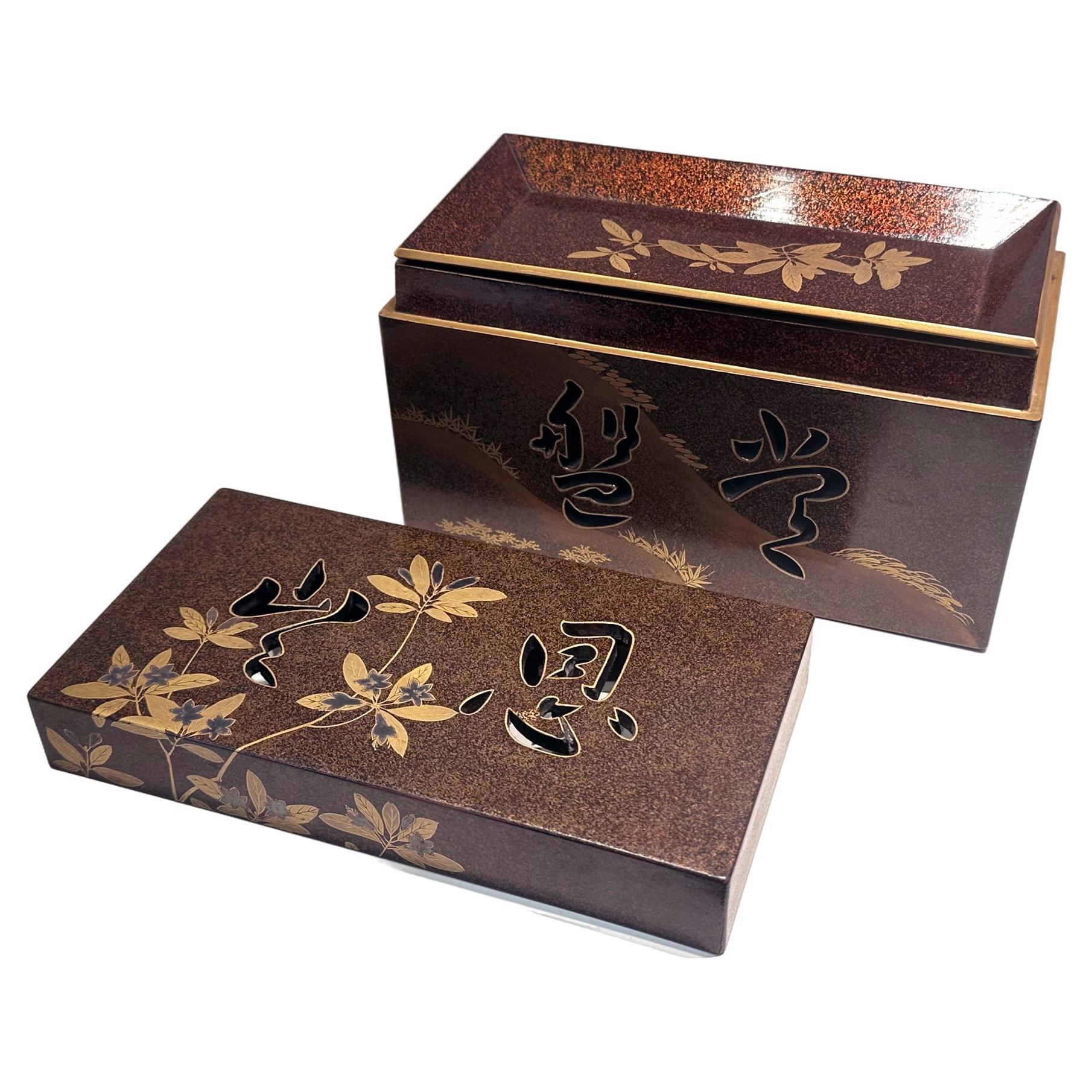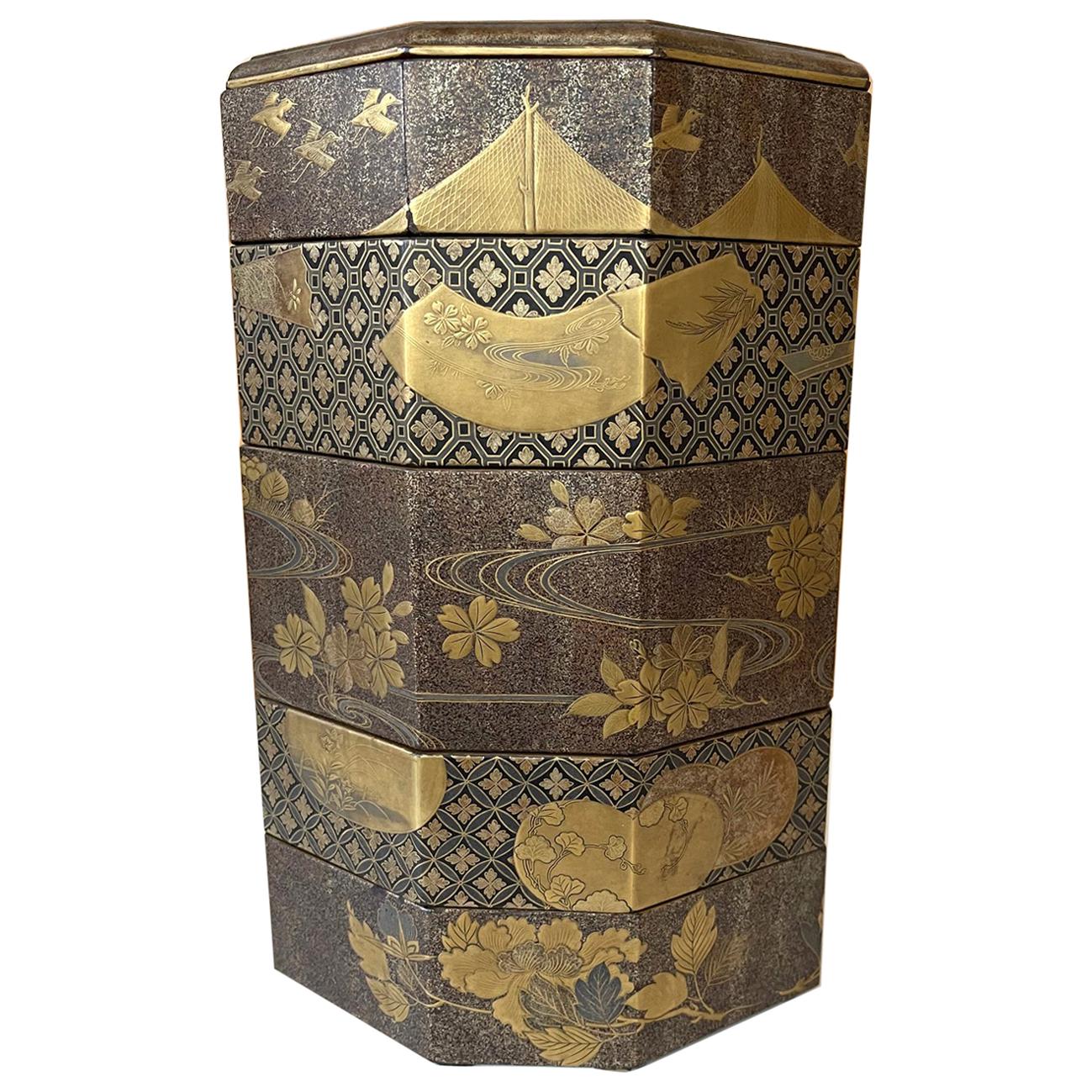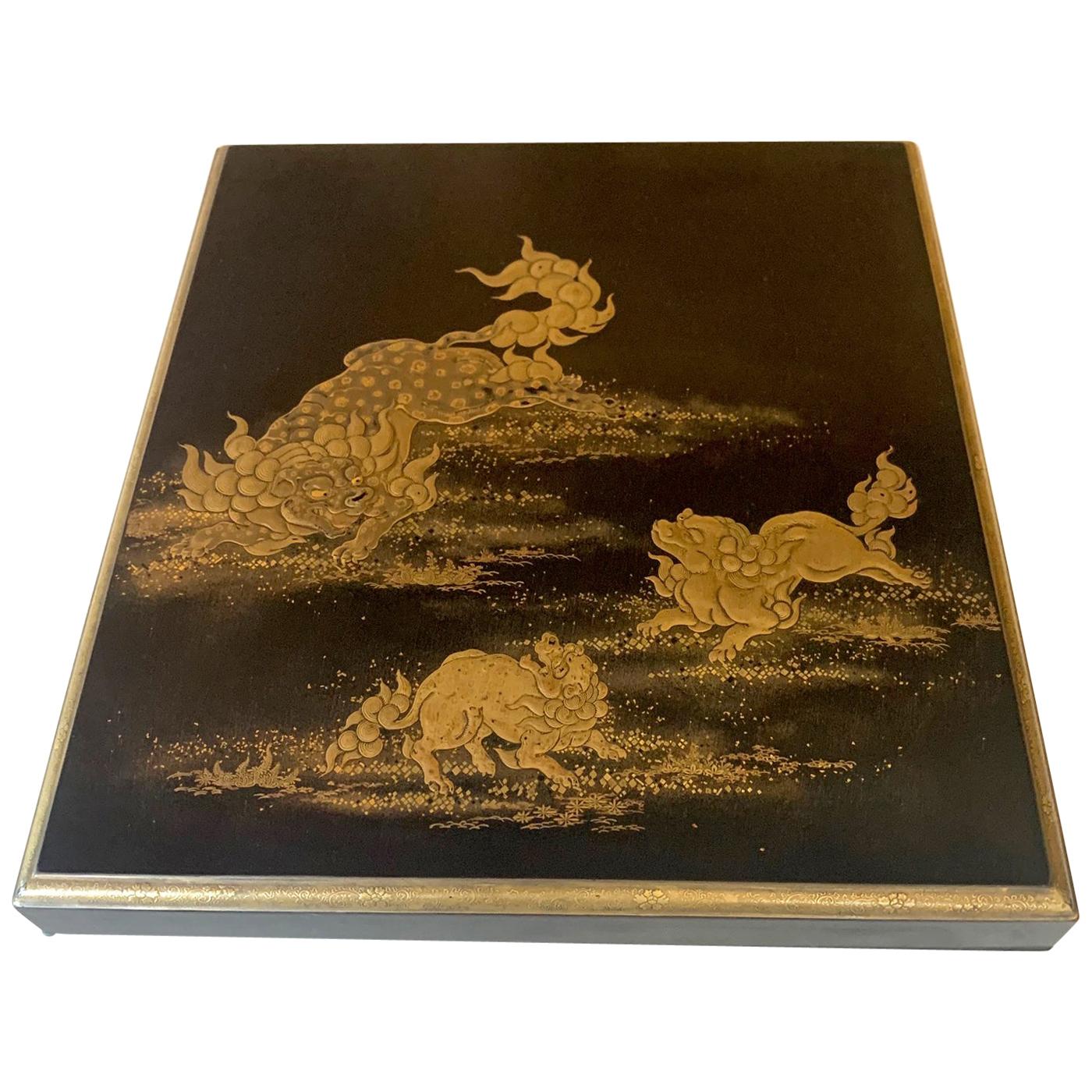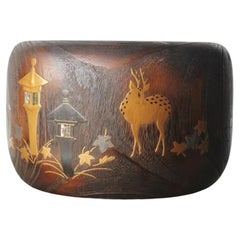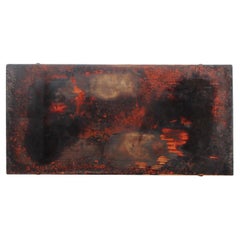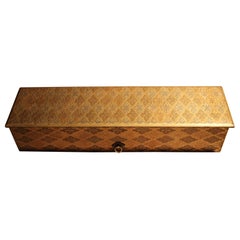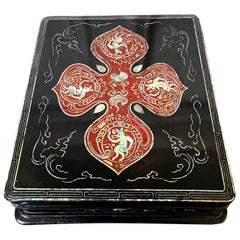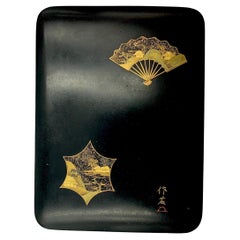Items Similar to Japanese Antiques Inkstone box with Kasuga Deer Mandala Maki-e by Kan-sai
Want more images or videos?
Request additional images or videos from the seller
1 of 21
Japanese Antiques Inkstone box with Kasuga Deer Mandala Maki-e by Kan-sai
About the Item
245(W)× 50(H) × 250(D) [mm]
Box size: 280(W)× 100(H) × 300(D) [mm] 1.6kg
A beautiful composition of a mother and child deer is expressed in Taka-maki-e (raised maki-e technique)
Open the lid and you will see a torii gate
The Kasuga Deer Mandala is famous, depicting a divine deer, said to be the messenger of Kasuga God, flying in on a cloud, with the sacred mountains of Kasuga Shrine, Mikasayama and Kasugayama, in the background, so is this composition related to that?
Koma Kan-sai was a master of inro maki-e, renowned alongside Hara Yoyusai
Is this work by another disciple? There is a lacquer signature "寛哉(可祝)", but the exact artist is unknown at first glance, but this work was created with solid skill.
There is some warping and small scratches on the edges. It shows some signs of use.
Water droplets and an Akama inkstone are attached.
With a box and a signature on the lid.
- Dimensions:Height: 1.97 in (5 cm)Width: 9.85 in (25 cm)Depth: 9.85 in (25 cm)
- Materials and Techniques:
- Place of Origin:
- Period:
- Date of Manufacture:Meiji-era
- Condition:Minor structural damages. There is some warping and small scratches on the edges. It shows some signs of use. Water droplets and an Akama inkstone are attached. With a box and a signature on the lid.
- Seller Location:Niiza, JP
- Reference Number:1stDibs: LU10264243868492
About the Seller
New to 1stDibs
Joined in the past six months.
No Reviews Yet
Vetted Professional Seller
Every seller passes strict standards for authenticity and reliability
Established in 2012
1stDibs seller since 2025
- ShippingRetrieving quote...Shipping from: Niiza, Japan
- Return Policy
Authenticity Guarantee
In the unlikely event there’s an issue with an item’s authenticity, contact us within 1 year for a full refund. DetailsMoney-Back Guarantee
If your item is not as described, is damaged in transit, or does not arrive, contact us within 7 days for a full refund. Details24-Hour Cancellation
You have a 24-hour grace period in which to reconsider your purchase, with no questions asked.Vetted Professional Sellers
Our world-class sellers must adhere to strict standards for service and quality, maintaining the integrity of our listings.Price-Match Guarantee
If you find that a seller listed the same item for a lower price elsewhere, we’ll match it.Trusted Global Delivery
Our best-in-class carrier network provides specialized shipping options worldwide, including custom delivery.More From This Seller
View AllJapanese Antiques A paulownia lacquer Makie brazier with a deer and a lantern
Located in Niiza, JP
φ310× 205(H) [mm]
Box size: φ340×240㎜ 4㎏
Lovely design
A Kasuga lantern with a cute male and female deer in raised lacquer.
The grey parts are made with lead.
The window of the lant...
Category
Antique 19th Century Japanese Lacquer
Materials
Wood
Japanese Antiques Mitamura Jiho Ivy Makie(Lacquer) Paper Box for calligraphy
Located in Niiza, JP
Mitamura Jiho 三田村自芳 Ivy Makie Lacquer Paper Box
290(W)× 130(H) × 365(D) [mm]
He have studied makie under Akatsuka Jitoku, the 8th master of the Edo makie Akatsuka school
He is an un...
Category
20th Century Japanese Lacquer
Materials
Wood, Lacquer
Japanese Antiques Lacquer craftsman's workbench, Abstract Painting
Located in Niiza, JP
Material: mainly Cedar board
A workbench used by lacquer craftsman.
Through years of use, natural layers of lacquer have formed, giving it a beautiful appearance like an abstract pa...
Category
Antique 19th Century Lacquer
Materials
Wood
Japanese Antiques Kokukokai Senzan lacquer painting “White Clouds Fuji” framed
Located in Niiza, JP
material: lacquer pain, metal frame with wood box
The Kokkokai is a group of maki-e artists formed in 1931 around Matsuda Gonroku, a Living National Treasure and Japan's proud maste...
Category
Antique 19th Century Lacquer
Materials
Lacquer
Japanese Antiques Nakajima Kaho, lacquer painting, cat, Folding fan-shaped frame
Located in Niiza, JP
Material: lacquer paint on paper
A cute lacquer painting of a cat.
A painter of the Maruyama(円山) school,
he is said to have learned calligraphy
from Tomioka Tessai(富岡鉄斎)
It is l...
Category
20th Century Lacquer
Materials
Paper
Japanese Antiques a basket by Chikuryu-sai Yamamoto(山本竹龍齋) lotus Bamboo
Located in Niiza, JP
Material: lotus and bamboo
Made by Yamamoto Chikuryusai,
a bamboo craftsman from Osaka Prefecture.
Chikuryusai took the name "Yamamoto Shoen 山本笙園"
in his later years.
Because he...
Category
Vintage 1920s Japanese Antiquities
Materials
Bamboo
You May Also Like
Edo Maki-e Japanese Box
Located in Brescia, IT
Japanese box with lacquer lid finely decorated with Maki-e, dating from the 18th century, mid-Edo period.
The box is of special size to preserve important calligraphy.
All sides of ...
Category
Antique Late 18th Century Japanese Edo Lacquer
Materials
Gold Leaf
$3,011
Unusual Japanese Lacquer Inkstone Box with MOP Inlays
Located in Atlanta, GA
A Japanese black lacquer box with mother of pearl inlays circa early 20th century, end of Meiji period. It was likely to be used to store inkstone or other scholarly items. The piece displays several interesting characteristics that appear puzzling initially. First, the form is not typical Japanese, but more Chinese and Korean, with its scalloped base. Second, the decoration of MOP inlays also suggests a Korean and Chinese affiliation, especially with the linear borders and the scrolling cloud patters on the sides of the box. These two observations suggest that the box may be from Ryukyu Island instead of Japanese mainland. Third, strikingly in the center of the cover, a bold quarterly floral pattern outlined with MOP was filled with a striking mottled red lacquer using tsugaru nuri...
Category
Early 20th Century Japanese Japonisme Lacquer
Materials
Wood, Lacquer
Japanese Meiji Period Antique Lacquer Box with Gold Maki-e Decoration
Located in New York, NY
A fine antique Japanese Meji Period lacquer box decorated with a fan and a stylized star shaped window in the maki-e technique. The fan at the top right corner, fully opened depictin...
Category
Antique 19th Century Japanese Meiji Lacquer
Materials
Lacquer
Japanese Maki-e Lacquer Tray Box with Cutout Design
Located in Atlanta, GA
A Japanese lacquer box with lid and an inner tray decorated with Maki-e on a dense nashiji background. The fine box was likely made circa 1920-30s...
Category
Vintage 1920s Japanese Taisho Lacquer
Materials
Wood, Lacquer
Japanese Maki-e Lacquer Stack Box Jubako
Located in Atlanta, GA
An antique jubako (stack boxes) with five tiers in an elongated octagon shape circa 19th century (end of Edo or beginning of Meiji period). jubako was traditionally used to store and...
Category
Antique 19th Century Japanese Japonisme Lacquer
Materials
Wood, Lacquer
Japanese Lacquer Box with Fine Maki-e Decoration Meiji Period
Located in Atlanta, GA
A lacquered wood box with lid from Japan circa 19th century Meiji Period. The finely decorated box was used to store paper slips and small documents on the desk. It is overall finished with black lacquer (kuro) with sparse Mura-Nashiji effect outside and on the top surface of the lid, there are three Komainu, (sometimes known as Shishi or Japanese lions) frolicking and forming a circle in lively motion. Komainu are auspicious animals in Japanese cultures in both Shinto and Buddhism tradition. Originally from China, these animals symbolizes guardians to ward off evil spirits. Hiramaki-e was used in combination with carving and combing to render the lions with various surface textures. A gilt border with an slight angle was given to the lid and even the thin band is decorated with miniature floral scrolls. The interior of the box was finished in a dense nashiji. Underneath the lid, a cluster of peonies open lavishly by two gentle mounts. Takamaki-e (high relief) in both gold and silver were...
Category
Antique Late 19th Century Japanese Japonisme Lacquer
Materials
Wood, Lacquer
Recently Viewed
View AllMore Ways To Browse
Antique Shrine
Asian Shrine
Antique Artist Paint Box
Small Antique Japanese Box
Japanese Antique Shrines
Black Lacquered Antique Box
Black Sai
Japanese Inro
Meiji Shrine
Antique Mandala
Japanese Inro Box
Japanese Inro Boxes
Torii Gate
Inro Box
Japanese Torii Gate
Antique Hara
Antique Sai
Chinese Export Lacquer Chess

